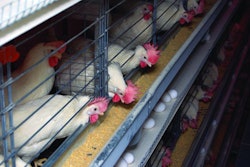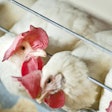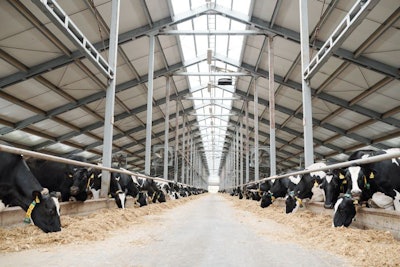
Trace mineral inclusions change during the dairy cow’s transition period, when its productivity and health can be greatly affected by their presence or absence.
The transition period is a time of great physiological change in dairy cattle and there are also changes in the levels of trace minerals.
A nice example is zinc (Zn). If we look at the level of plasma zinc around calving, there is a marked reduction. The same is true for some other minerals, as well as vitamin E. This is a natural occurrence, but one that can be exacerbated by poorly balanced rations, inadequate mineral supply or infectious disease challenge.
If we look at the incidence of clinical mastitis for the same time period, we can see that it peaks around the same time as the drop in plasma Zn and other trace minerals occurs. Given the role of these types of minerals in antioxidant, immune and metabolic function, it’s easy to see how this relationship occurs. Several trace minerals are involved in the antioxidant defense system, and a deficiency in any of these nutrients may depress the immunity of transition cows.
Minerals and immunity
Indeed, if we look a little more closely at the competence of immune function around calving, there is a body of evidence showing a drop in the efficacy of neutrophils in animals with varying degrees of metritis.
Certain trace minerals are involved in protein synthesis, for example, Zn, which is required during the process that involves the “reading” of DNA to make proteins. Carbohydrate and lipid metabolism are also affected by the presence or absence of trace minerals, mainly because they form part of many enzymes. Minerals, such as selenium (Se), are known to have a direct effect on the immune system and many others, like copper (Cu), are involved in processes that have an indirect effect. Copper plays an important role in the transportation of iron (Fe) around the body and is also implicated in survival of the young embryo.
Negative energy balance (NEB) is inevitable post-calving and, given the negative impact of it on the immune system, it becomes even more important to support the immune system by any means.
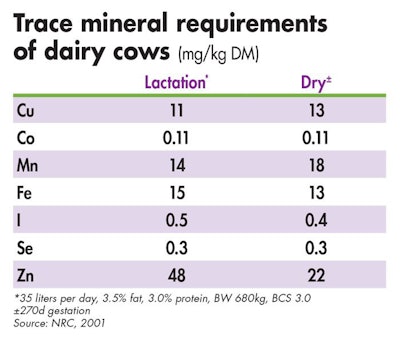
Knowing your forages
Table 1 gives the NRC (2001) recommendations for trace minerals in Holstein Friesian dairy cows, lactating and dry. For example, a dry cow eating 11 kg of DM requires ~143 mg of Cu. The nutritionist’s job is to match requirement with supply so understanding not only what animals require but what is in the background diet is critical. This is especially important when it comes to forages.
Forages represent one of the most variable aspects to a dairy cow ration and, while it’s common practice to analyze for parameters, such as energy, protein, fat and fiber, it’s less common to analyze for a comprehensive suite of minerals.
With the use of mineralized feed and mineral premixes, we’ve generally assumed that these would satisfy, and more, the requirements of the animal. That said, with the advent of precision feeding and livestock production, the appreciation of the fact that more may not always be better, as well as increasing pressure to reduce pollution, feeding minerals is starting to become a more tailored and precise operation. Ensuring optimal mineral provision relies on knowing what’s in the background diet, especially in the forage, which can vary significantly.
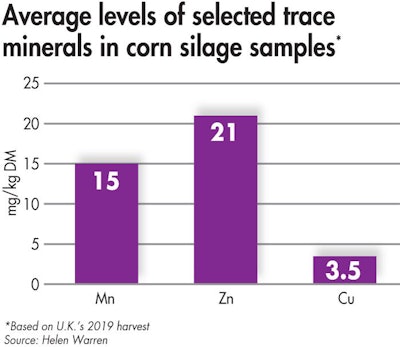
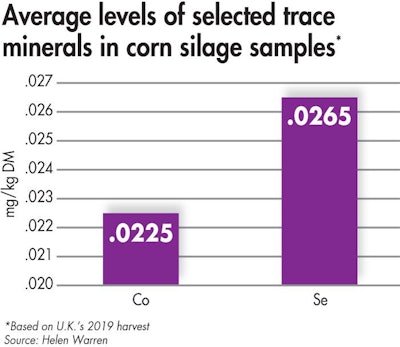
Average levels of selected trace minerals in corn silage samples from the 2019 UK harvest, i.e. A = manganese (Mn), zinc (Z) and copper (Cu); B =cobalt (Co) and selenium (Se). (Helen Warren)
Figure 1 shows the average levels of key trace minerals in maize silage produced in the United Kingdom from the 2019 harvest. These data are from multiple 2019 maize silage samples. Analyzing forage for minerals allows you to gauge mineral supply more precisely from the background diet, enabling the formulation of bespoke mineral specifications.
Take Zn for example: A dry cow eating 8kg dry matter (DM) of maize silage at 20.7mg of Zn/kg would get 165.6mg/d, just over half her daily Zn requirements (301mg/h/d).
Mineral interactions
Other minerals we are interested in would include so-called antagonists, trace minerals that have the capacity to reduce the availability of other minerals, such as Cu and Zn, as well as magnesium (Mg) and phosphorus (P).
As Mg is one of the critical minerals for the dry period, having knowledge of levels of antagonists in the diet is important. Molybdenum, Fe and aluminum (Al) are common examples of these antagonists. Grass silage tends to have higher levels of antagonists compared with maize or whole crop silage. You can use this information to inform any decisions on levels of supplied minerals.
It is important to remember that the NRC (2001) recommendations are simply those required to prevent deficiency symptoms, with minimal interference from factors, such as antagonists, rather than those for optimal health and performance. Minerals must make a substantial journey to reach the site of absorption and have to make it through a range of pH to get there. The form in which the mineral is presented to the gut has quite an influence on its stability through the gut and whether it reaches the site of absorption. Once there, there are various uptake mechanisms and pathways available, depending on the form the mineral is. Different mineral sources will have different availability and this needs to be considered.
Trace minerals and fertility
Some minerals play critical roles in fertility. Cu, Zn and Se are involved in the antioxidant enzyme complexes, superoxide dismutase (SOD) and glutathione peroxidase (GPX). Greater antioxidant levels in the early postpartum period have been associated with normal luteal activity, earlier resumption of cyclicity, decreased pregnancy loss and increased conception rate in Holstein dairy cows.
Additionally, micronutrient supplementation during the transition period has been shown to improve calving condition and reduce the time interval between calving and first service. Trace minerals have also been implicated in ameliorating some of the effects of heat stress in pregnant cows.
Data from one study infer that zinc treatment ameliorates the adverse effects of heat stress and augments immunity during heat stress in periparturient Sahiwal and Karan Fries cows. Supplementing amino acid-complexed trace minerals during the transition period resulted in greater DM intake and milk yield in the first 30 days in milk, as well as an increase in polymorphonuclear neutrophilic lymphocyte (PMNL) phagocytosis, antioxidant capacity postpartum and overall concentration of liver tissue Co and Cu.
In a long-term study with trace mineral proteinates replacing all inorganic forms of Cu, Mn, Zn and Se in the diets of transition cows and their subsequent heifer calves, fertility and 100-day milk production was improved in the heifers.
Conclusion
Minerals have numerous and diverse roles in the body with many crucial indirect effects on metabolism. Optimal supply is important throughout the production cycle but particularly during the transition period, which represents a time of significant physiological change and increased susceptibility to disease.
Trace minerals are involved in immune function, antioxidant defense and fertility, further highlighting their significance. To be able to ensure optimal supply, it is essential to know what’s in the background diet, especially in the forages as this represents the most variable source. Consequently, mineral analysis of forage is vital.
References available upon request.
Editor’s note: This is the second installment in a two-part series examining the importance of microingredients in dairy rations.



